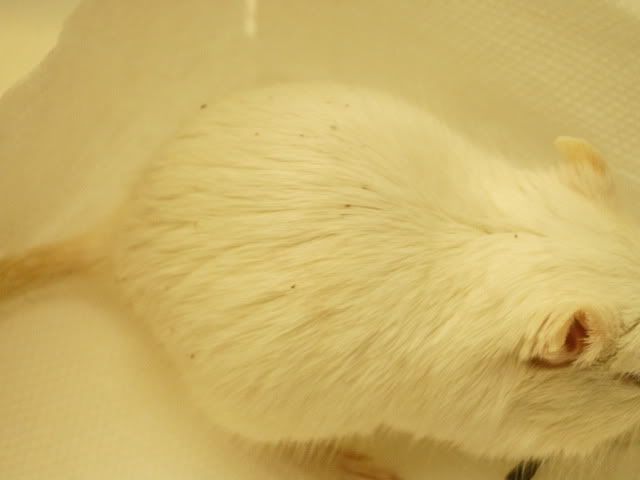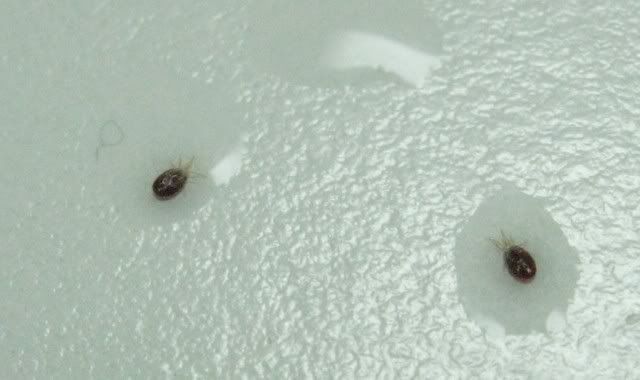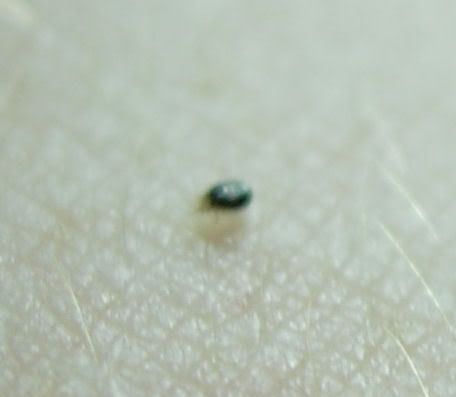Post by Shooting Star on Aug 11, 2007 12:25:05 GMT -8
So, you think you might have mites.  Read on to find out how to make them go away-- and how to make sure they stay gone!
Read on to find out how to make them go away-- and how to make sure they stay gone!
*Note: The majority of the information in this FAQ is specific to Tropical Fowl Mites (Ornithonyssus bursa), not Demodex or other types of mites. Please see your vet to determine which mites you are dealing with, as the treatment will depend on the species.
------------------------------------------------------------------------------------
Symptoms:
Infested gerbils will often have a rumpled coat, and can be seen scratching and grooming excessively. You may see tiny black, red, or even see-through dots moving on the bedding, tank walls, or the gerbils themselves. Bite marks can be seen on young pups that are not fully furred yet, but the fur of adults is usually too thick to see the bites.

^ A young pup with bites on the mouth, ear, paw, and torso.

^ A severely infested adult (all the dark dots are mites).
If you suspect your gerbil has mites, you can check by wrapping the gerbil in white toilet paper or paper towels. Wait for a minute, and then examine the paper for moving red, black, or clear dots. These are probably mites. You should save a few in a plastic bag to show your vet. They can determine what kind of mite you are dealing with.
Causes:
Mites are small, blood-sucking arachnids. There are also types of mites that do not feed on blood, like dust mites. They usually come from infested food or bedding. Freezing food and bedding before use should kill any parasites in the bags.

^ Mites, trapped in drops of water.

^ A mite on human skin.
At-Risk Groups:
Mite infestations are supposedly rare, but outbreaks have been a problem recently during the warmer months, particularly in the US.
The number of bites a gerbil can suffer during a severe infestation may cause them to become dangerously anemic, especially young and elderly gerbils. Gerbils with a lowered immune system due to anemia are much more susceptible to other illnesses.
Treatment:
During a mite outbreak, there are two problems that need to be dealt with. The infested tanks and equipment need to be treated, and the gerbils themselves need to be treated.
Keep in mind that the mites may also attack *you*, especially after the gerbils have been treated. Wash your clothes at a high temperature setting, and shower with Head and Shoulders Shampoo after you do any major cleaning (tanks, shelves, etc.).
Treating Gerbils
The gerbils need to be medicated to discourage mites from biting them. Treat all of the gerbils, whether they seem to have mites or not. The most commonly prescribed medication for Demodex mites is Ivermectin (or a derivative thereof), delivered orally or by injection. Follow your vet’s instructions carefully. You can buy Ivermectin in feed stores without a prescription and prepare it yourself, but I would not recommend doing so unless you have access to the appropriate equipment and experience in mixing, dosing, and delivering medications to small animals (and preferably, the consent/advice of a licensed veterinarian). If you are in the UK, there is also an over-the-counter Ivermectin treatment designed for hamsters and gerbils, made by Beaphar.
A very effective alternative to Ivermectin is the flea-and-tick medication Frontline, marketed for dogs and cats. Frontline is not approved for small animal use, but has been used by a handful of owners (on newborn pups through elderly gerbils) without adverse side effects. Push the fur aside to bare a patch of skin on the back of the gerbil’s neck, and put 1-2 drops of Frontline on the exposed skin. Make sure the medicine is absorbed into the skin before putting the gerbil back in its tank, to that its tankmates do not groom it off. One round of Frontline should stop the mites from biting within 1-2 weeks. Selamectin, the active ingredient in Revolution, has been affective in treating some mites in mice.
Some sources recommend using a commercial small animal flea and mite spray with a 0.66% Permethrin concentration. However, the stress involved in spraying the gerbils, as well as the risk of illness from being cold and wet, may make Ivermectin or Frontline/Revolution treatment a better course of action.
Cleaning Tanks and Equipment
All tanks need to be cleaned thoroughly and disinfected. You will need to clean and disinfect the gerbils’ housing each week until the mites are completely gone. It is easiest to move the gerbils to temporary bin-cages until the mites are completely gone, as they are easier to clean than glass tanks. Mites have been known to lay eggs in the silicone seals of glass tanks, so it is best to keep the (disinfected) tanks well away from the gerbils until the infestation has been dealt with.
Old bedding should be put in a plastic garbage bag, and ideally, sprayed with pesticide, before being taken to an outside dumpster. Make sure to keep items that have been cleaned well away from those that have yet to be disinfected, to prevent cross-contamination.
Anything that has been in contact with the gerbils should be washed with hot or boiling water, mixed with bleach (1 part bleach to 10 parts water). Rinse with more hot or boiling water, this time without the bleach. You will want to wear rubber gloves, to keep your hands from being scalded. Wooden toys and other things that won’t survive hot bleach water should be baked, frozen, or thrown away. If you put wooden toys in the oven or microwave, make sure they don’t have any metal staples or pins!
Water bottles made of glass or thick plastic (like the Oasis Bell Bottles) will be okay in hot or boiling water, but others will melt, so be careful. If you have the thinner plastic water bottles, you can use lukewarm bleach water, but make sure to rinse well. Mites will hide out inside the metal spout, and in the grooves of the screw-on top, so remember to wash those as well as the bottle itself.
Cleaning Rooms and Shelves
For cleaning surfaces, I would suggest Ready-to-Use Sevin Spray. The spray will need to be diluted, just under 2 oz. Sevin spray to 30 oz. water.
If the room where the gerbils were originally is carpeted,vacuum the entire room *thoroughly*, and put some diluted Sevin spray on a rag to wipe down the baseboards. Move the shelves (or whatever the tanks were resting on) somewhere that's not carpeted, and follow the instructions for a non-carpet room below to clean them.
If the original room is not carpeted, your job is much simpler. Pull the shelves (etc.) away from the wall, and use the (diluted) Sevin spray on the shelves, the walls, the baseboards, the floor-- everything that can be sprayed. Let the room dry for a few hours, with some fans on. The spray will take several days to kill all the mites, so be prepared to vacate the room for a time.
Further Information:
Gönenç, B., Sarimehmetoğlu, H. O., Iça, A., Kozan, E. 2006. Efficacy of selamectin against mites (Myobia musculi, Mycoptes musculinus and Radfordia ensifera) and nematodes (Aspiculuris tetraptera and Syphacia obvelata) in mice. Laboratory Animals 40: 210-213
Levine JF, Lage AL. 1984. House mouse mites infesting laboratory rodents. Lab Anim Sci 34:393-394.
Reynolds SL, Gainer JH. 1968. Dermatitis of Mongolian gerbils (Meriones unguiculatus) caused by Demodex sp. Abstract #150, 19th Annual Meeting AALAS; Las Vegas, NV.
Schwarzbrott SS et al. 1974. Demodicosis in the Mongolian gerbil (Meriones unguiculatus): a case report. Lab Anim Sci 24:666-668.
Vincent AL et al. 1975. Spontaneous lesions and parasites of the Mongolian gerbil, Meriones unguiculatus. Lab Anim Sci 25:711-722.
--------------------------------------------------------------------------------------
 Read on to find out how to make them go away-- and how to make sure they stay gone!
Read on to find out how to make them go away-- and how to make sure they stay gone!*Note: The majority of the information in this FAQ is specific to Tropical Fowl Mites (Ornithonyssus bursa), not Demodex or other types of mites. Please see your vet to determine which mites you are dealing with, as the treatment will depend on the species.
------------------------------------------------------------------------------------
Symptoms:
Infested gerbils will often have a rumpled coat, and can be seen scratching and grooming excessively. You may see tiny black, red, or even see-through dots moving on the bedding, tank walls, or the gerbils themselves. Bite marks can be seen on young pups that are not fully furred yet, but the fur of adults is usually too thick to see the bites.

^ A young pup with bites on the mouth, ear, paw, and torso.

^ A severely infested adult (all the dark dots are mites).
If you suspect your gerbil has mites, you can check by wrapping the gerbil in white toilet paper or paper towels. Wait for a minute, and then examine the paper for moving red, black, or clear dots. These are probably mites. You should save a few in a plastic bag to show your vet. They can determine what kind of mite you are dealing with.
Causes:
Mites are small, blood-sucking arachnids. There are also types of mites that do not feed on blood, like dust mites. They usually come from infested food or bedding. Freezing food and bedding before use should kill any parasites in the bags.

^ Mites, trapped in drops of water.

^ A mite on human skin.
At-Risk Groups:
Mite infestations are supposedly rare, but outbreaks have been a problem recently during the warmer months, particularly in the US.
The number of bites a gerbil can suffer during a severe infestation may cause them to become dangerously anemic, especially young and elderly gerbils. Gerbils with a lowered immune system due to anemia are much more susceptible to other illnesses.
Treatment:
During a mite outbreak, there are two problems that need to be dealt with. The infested tanks and equipment need to be treated, and the gerbils themselves need to be treated.
Keep in mind that the mites may also attack *you*, especially after the gerbils have been treated. Wash your clothes at a high temperature setting, and shower with Head and Shoulders Shampoo after you do any major cleaning (tanks, shelves, etc.).
Treating Gerbils
The gerbils need to be medicated to discourage mites from biting them. Treat all of the gerbils, whether they seem to have mites or not. The most commonly prescribed medication for Demodex mites is Ivermectin (or a derivative thereof), delivered orally or by injection. Follow your vet’s instructions carefully. You can buy Ivermectin in feed stores without a prescription and prepare it yourself, but I would not recommend doing so unless you have access to the appropriate equipment and experience in mixing, dosing, and delivering medications to small animals (and preferably, the consent/advice of a licensed veterinarian). If you are in the UK, there is also an over-the-counter Ivermectin treatment designed for hamsters and gerbils, made by Beaphar.
A very effective alternative to Ivermectin is the flea-and-tick medication Frontline, marketed for dogs and cats. Frontline is not approved for small animal use, but has been used by a handful of owners (on newborn pups through elderly gerbils) without adverse side effects. Push the fur aside to bare a patch of skin on the back of the gerbil’s neck, and put 1-2 drops of Frontline on the exposed skin. Make sure the medicine is absorbed into the skin before putting the gerbil back in its tank, to that its tankmates do not groom it off. One round of Frontline should stop the mites from biting within 1-2 weeks. Selamectin, the active ingredient in Revolution, has been affective in treating some mites in mice.
Some sources recommend using a commercial small animal flea and mite spray with a 0.66% Permethrin concentration. However, the stress involved in spraying the gerbils, as well as the risk of illness from being cold and wet, may make Ivermectin or Frontline/Revolution treatment a better course of action.
Cleaning Tanks and Equipment
All tanks need to be cleaned thoroughly and disinfected. You will need to clean and disinfect the gerbils’ housing each week until the mites are completely gone. It is easiest to move the gerbils to temporary bin-cages until the mites are completely gone, as they are easier to clean than glass tanks. Mites have been known to lay eggs in the silicone seals of glass tanks, so it is best to keep the (disinfected) tanks well away from the gerbils until the infestation has been dealt with.
Old bedding should be put in a plastic garbage bag, and ideally, sprayed with pesticide, before being taken to an outside dumpster. Make sure to keep items that have been cleaned well away from those that have yet to be disinfected, to prevent cross-contamination.
Anything that has been in contact with the gerbils should be washed with hot or boiling water, mixed with bleach (1 part bleach to 10 parts water). Rinse with more hot or boiling water, this time without the bleach. You will want to wear rubber gloves, to keep your hands from being scalded. Wooden toys and other things that won’t survive hot bleach water should be baked, frozen, or thrown away. If you put wooden toys in the oven or microwave, make sure they don’t have any metal staples or pins!
Water bottles made of glass or thick plastic (like the Oasis Bell Bottles) will be okay in hot or boiling water, but others will melt, so be careful. If you have the thinner plastic water bottles, you can use lukewarm bleach water, but make sure to rinse well. Mites will hide out inside the metal spout, and in the grooves of the screw-on top, so remember to wash those as well as the bottle itself.
Cleaning Rooms and Shelves
For cleaning surfaces, I would suggest Ready-to-Use Sevin Spray. The spray will need to be diluted, just under 2 oz. Sevin spray to 30 oz. water.
If the room where the gerbils were originally is carpeted,vacuum the entire room *thoroughly*, and put some diluted Sevin spray on a rag to wipe down the baseboards. Move the shelves (or whatever the tanks were resting on) somewhere that's not carpeted, and follow the instructions for a non-carpet room below to clean them.
If the original room is not carpeted, your job is much simpler. Pull the shelves (etc.) away from the wall, and use the (diluted) Sevin spray on the shelves, the walls, the baseboards, the floor-- everything that can be sprayed. Let the room dry for a few hours, with some fans on. The spray will take several days to kill all the mites, so be prepared to vacate the room for a time.
Further Information:
Gönenç, B., Sarimehmetoğlu, H. O., Iça, A., Kozan, E. 2006. Efficacy of selamectin against mites (Myobia musculi, Mycoptes musculinus and Radfordia ensifera) and nematodes (Aspiculuris tetraptera and Syphacia obvelata) in mice. Laboratory Animals 40: 210-213
Levine JF, Lage AL. 1984. House mouse mites infesting laboratory rodents. Lab Anim Sci 34:393-394.
Reynolds SL, Gainer JH. 1968. Dermatitis of Mongolian gerbils (Meriones unguiculatus) caused by Demodex sp. Abstract #150, 19th Annual Meeting AALAS; Las Vegas, NV.
Schwarzbrott SS et al. 1974. Demodicosis in the Mongolian gerbil (Meriones unguiculatus): a case report. Lab Anim Sci 24:666-668.
Vincent AL et al. 1975. Spontaneous lesions and parasites of the Mongolian gerbil, Meriones unguiculatus. Lab Anim Sci 25:711-722.
--------------------------------------------------------------------------------------

